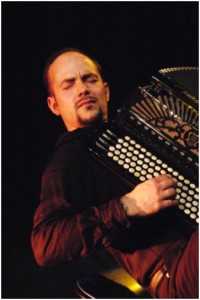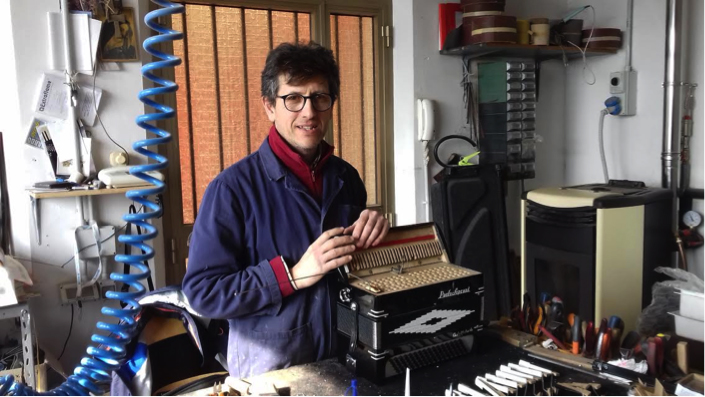Fisarmoniche Alessandrini – un marchio ed una azienda “in giro” per il mondo… insegnando!
CASTELFIDARDO (AN) – Inutile negare il fascino che si prova entrando nel laboratorio, termine più moderno, una volta si sarebbe detto la bottega, della ditta Alessandrini. Ci troviamo nel popoloso quartiere Fornaci appena alla periferia di Castelfidardo. Si arriva in via Verdi, 83 percorrendo un giro vizioso. Ma in effetti la stradina a senso unico in discesa non consentirebbe altri percorsi.
Già dall’esterno le grandi vetrate permettono di percepire la gestualità di chi ci lavora. Ad accoglierci è Tonino Alessandrini, che con la sorella Daniela rappresentano la seconda generazione di questo marchio.
 L’azienda nasce infatti nel 1952 per opera dello zio Genuino. Il fratello Alfredo, da poco andato in pensione, ma che non disdegna ancora utili suggerimenti, allora giovane operaio presso la “Paolo Soprani”, apprese il mestiere lavorando al mattino nella grande impresa e la sera dando una mano al fratello. Andò avanti così per alcuni anni. Poi negli anni sessanta decise di dedicarsi anche lui esclusivamente all’azienda di famiglia dando vita nel 1970 alla “Fratelli Alessandrini”.
L’azienda nasce infatti nel 1952 per opera dello zio Genuino. Il fratello Alfredo, da poco andato in pensione, ma che non disdegna ancora utili suggerimenti, allora giovane operaio presso la “Paolo Soprani”, apprese il mestiere lavorando al mattino nella grande impresa e la sera dando una mano al fratello. Andò avanti così per alcuni anni. Poi negli anni sessanta decise di dedicarsi anche lui esclusivamente all’azienda di famiglia dando vita nel 1970 alla “Fratelli Alessandrini”.
In tutti questi anni di fisarmoniche ed organetti ne sono stati realizzati tantissimi. Ma su una cosa Tonino è intransigente.
“La qualità dei nostri prodotti è rimasta altissima. Nonostante i 32 modelli che compaiono nel nostro catalogo. Forse una esagerazione per una ditta artigiana a conduzione familiare che vive sulla disponibilità di due manualità e su qualche collaborazione esterna. Ma abbiamo sempre voluto tenere fede alle richieste del mercato”.
Dove esportate maggiormente i vostri strumenti e quali sono i più richiesti?
“Negli ultimi anni si è registrato un boom per le fisarmoniche classiche, quelle da concerto, ma si spazia anche nel diatonico. Le nazioni? Stati Uniti, Messico per il diatonico, la Norvegia, la Scozia, la Germania, l’Europa in generale, il Belgio su tutti. Qui abbiamo intrapreso anni fa la collaborazione con il M° Olivier Douez docente di fisarmonica al Conservatorio di Mons. Ma non si parla solo di produzione, ma anche di lezioni…”
Lezioni? In che senso?
“Tre o quattro volte l’anno ci rechiamo a Mons per tenere lezioni pratiche ai ragazzi frequentanti il Conservatorio. A loro diamo l’opportunità di apprendere dal vivo le fasi costruttive dello strumento, dunque anche la riparazione, aspetto quest’ultimo che per chi compra all’estero può essere un problema. Dunque sveliamo tutti i nostri “segreti”. È anche l’occasione giusta per riparare o riaccordare gli strumenti. In pratica portiamo il nostro laboratorio in giro per il mondo. In attesa che si formi lì qualche giovane che abbia voglia di apprendere questo mestiere”.
Questa è la problematica di sempre anche in Italia. Formare i giovani per dare il cambio a chi se ne è andato o sta per andare in pensione, come gli accordatori, specialità in estinzione.
“Si, ma non ci si sta riuscendo. Oggi, nonostante i corsi di formazione messi in piedi dalla Regione Marche, con il sostegno delle associazioni di categoria, non si riescono a scovare giovani interessati ed amanti di questo mestiere. In tanti ci provano, è vero, ma poi quasi sempre rinunciano perché dicono sia troppo faticoso. Eppure è un lavoro che ha un futuro e che può dare tante soddisfazioni.
La criticità segnalata da chi compra all’estero è da sempre quella delle assistenze.
“La fisarmonica è uno strumento che ne necessità in continuazione. Ho avuto l’idea di organizzare proprio in Belgio un piccolo laboratorio in pianta stabile per evitare di portare ogni volta gli attrezzi di lavorazione dall’Italia. Quando ci saranno 10/15 strumenti da sistemare mi sposterò in loco per qualche giorno in maniera da svolgere il lavoro sul posto. Così si darà una risposta anche a chi chiede questo tipo di assistenza”.
Avete vissuto fin da piccoli intere giornate all’interno del laboratorio avendo la vostra abitazione al piano superiore. Può essere stato un sacrificio, ma anche un valore aggiunto?
Credo di poter affermare che quello che facevamo lì per gioco alla fine ci abbia fatto amare quello che oggi facciamo. Tanto da permetterci di conoscere tutte le fasi lavorative che allora si facevano tutte internamente. Per questo oggi abbiamo le competenze per poter costruire uno strumento in ogni particolare. Ne produciamo una media di 4-5 al mese. Conosciamo tutto il processo lavorativo. A mia sorella piace l’intonatura e la ceratura delle ance. Abbiamo anche dei collaboratori che ci danno esternamente una mano, ma poi tutto passa sotto la nostra supervisione per controllare il prodotto finale”.
Dalla vostra produzione emergono strumenti a bottoni da 96 o 120 bassi con o senza cassotto, oppure le Bajan da Conservatorio. Tutte rigorosamente prodotte a livello artigianale puro. Arrivano ancora richieste di personalizzare lo strumento?
“È difficile che ci sia chi sceglie a scatola chiusa. Stiamo logicamente parlando dei fisarmonicisti ai più alti livelli, insomma di chi fa dello strumento un motivo di vita o di professione. E chiede interventi non solo estetici ma anche sulle sonorità. Premesso che noi cerchiamo sempre di dare uno strumento curato nei dettagli, in questi casi la sua consegna si può prolungare anche di un paio di mesi rispetto al normale. Ma chi chiede questi tipi di interventi è ben contento di aspettare”.
Oggi il mercato è cambiato. Gli appuntamenti fieristici, una volta strumento di vendita, sono definitivamente superati dalle nuove tecnologie. Ne ha la percezione?
“È vero. Su tutte internet che ha consentito al cliente di aggiornarsi in tempo reale. Questo permette un risparmio anche economico e la possibilità di rispondere velocemente. Su FB ad esempio ho inserito anche mini lezioni di tecnica. Consultabili in qualsiasi circostanza. Hanno molte visualizzazioni. Segno del mutamento dei tempi. Si riesce velocemente anche a parlarsi/vedersi da un punto all’altro del globo”.
Nella piccola bottega sotto l’abitazione chi arriva coglie ancora il sapore dei gesti antichi. Dalla manualità ai più disparati attrezzi. Sembra di vedere quasi una parte della piccola bottega artigiana all’interno del museo che pochi chilometri più su esaltano questo strumenti. Eppure qui si sta pensando di cercare locali più ampi. Ma come staccarsi da un pezzo di storia? Ecco allora che si va avanti senza tentennamenti. Infondo da queste parti sembra di vivere un refrein continuo. Prima il padre, poi il figlio. Domani chissà. Forse un nipote a dare continuità ad un lavoro certosino che si tramanda da generazioni? Ed allora magari stretti ma avanti così, dove si respira ancora l’aria antica della modernità. Controsenso? Provare per credere.
————————————————————————————
Alessandrini Accordions – a brand “around” the world… teaching
CASTELFIDARDO (AN) – Needless to deny the charm that you feel going into the laboratory, modern term, that one time would have said the handcraft laboratory, the Alessandrini Accordions. We are located in the populous district Fornaci just on the outskirts of Castelfidardo. You get in via Verdi, 83 along a vicious route. Anyway the lane-way downhill would not allow other paths.
Already outside the large windows allow you to perceive the gestures of those who work there. Tonino Alessandrini welcomes me; he and his sister Daniela are the second generation of this brand.
 The company was, in fact, created in 1952 by the power of their uncle Genuino. His brother Alfredo, recently retired, but he doesn’t still disdain tips, then a young worker at the “Paolo Soprani”, learned the trade working in the morning in the big enterprise and on the evening helping his brother. This went on for a few years. Then in the 60’s he decided to devote himself exclusively to the family business, giving birth in 1970 to the “Fratelli Alessandrini Accordions”.
The company was, in fact, created in 1952 by the power of their uncle Genuino. His brother Alfredo, recently retired, but he doesn’t still disdain tips, then a young worker at the “Paolo Soprani”, learned the trade working in the morning in the big enterprise and on the evening helping his brother. This went on for a few years. Then in the 60’s he decided to devote himself exclusively to the family business, giving birth in 1970 to the “Fratelli Alessandrini Accordions”.
In all these years they have been realized many accordions and diatonic accordions, but on one thing Tonino is intransigent.
“The quality of our products has remained extremely high, despite the 32 models that appear in our catalogue. Perhaps an exaggeration to an artisan family business that lives on the availability of two workers and some external collaboration. But we always wanted to live up to market demands”.
Where do you exported your instruments more and what are the most popular products?
“In the last few years there has been a boom for classic accordions, those for concert performance, but it also ranges in diatonic. The countries? United States, Mexico for the diatonic, Norway, Scotland, Germany, all over Europe, Belgium on all. There we have undertaken some years ago in collaboration with Maestro Olivier Douez accordion teacher at the Conservatory of Mons. Furthermore, we do not just talking about production, but also of lessons … ”
“Three or four times a year we go to Mons to hold practical lessons to students attending the Conservatory. We give them the opportunity to learn the phases of construction of the instrument, thus including the repair, the latter aspect that for buyers abroad can be a problem. So we reveal all of our “secrets”. It is also a good time to repair or retune the accordions. Practically, we bring our lab around the world, waiting for a few young who wants to be formed and can learn this profession”.
This is the problem of ever even in Italy: training young people to take over who is gone or about to retire, above all the tuners, endangered specialties.
“Yes, but it is failing. Today, despite the training courses organized by the Marche Region, with the support of industry associations, they will fail to find young people interested and lovers of this craft. In many they try, it is true, but then almost always give up because they say it’s too tiring. Yet it is a job that has a future and can give great satisfaction.
 The critical issues reported by those who buy abroad has always been of assistance.
The critical issues reported by those who buy abroad has always been of assistance.
“The accordion is an instrument that we need assistance all the time. I had the idea of organizing Belgium a small permanent laboratory to avoid bringing every time the tools from Italy. When there will be 10/15 instruments to fix I will move on site for a few days in order to carry out the work there. So it will give an answer to those who ask for such assistance”.
You have lived since childhood days on the laboratory having upstairs your apartment. It may have been a sacrifice, but also an added value?
“I think I can say that what we were doing there as a game at the end did we love what we do today. So much so that we can know all the processing stages that then there were made all internally. So today we have the expertise to build an instrument in every detail. We produce an average of 4-5 accordions per month. We know the whole working process. My sister likes the dubbing and waxing of the reeds. We also have external employees who give us a hand, but then everything goes under our supervision to control the final product”.
 From your productions emergebutton instruments up at 96 or 120 bass with or without cassotto, or the Bajan for Conservatory. All strictly produced in pure artisan level. You still receive request to customize the instrument?
From your productions emergebutton instruments up at 96 or 120 bass with or without cassotto, or the Bajan for Conservatory. All strictly produced in pure artisan level. You still receive request to customize the instrument?
“It is hard to think there is one who chooses sight unseen. We are, of course, talking about the accordion at the highest levels, in short, of those who make the instrument a matter of life or our job. It calls for action not only aesthetic but also about the sound. Given that we always try to give a well-finished instrument, in this case its delivery can also be extended by a few months compared to normal. But who asks these types of projects is well content to wait”.
Today the market has changed. The exhibitions, once important moment for the sales, is definitely overcome by new technologies. Are you agree?
“It’s true. Of all them, Internet allowed the customer to update in real time. This also allows cost savings and the ability to answer quickly. On Facebook, for example, I also added mini technique lessons, which are consulted forever. They have many views. Sign of the changing times. We can also quickly to talk / see each other all over the world”.
In the small laboratory under the house, who arrives, can still captures the flavour of the ancient gestures. From manual skills to a variety of tools. It seems to see almost a part of the small workshop in the museum that far more instruments to enhance this. Yet here you are thinking of trying to larger spaces. But how to break away from a piece of history? So here we go along without hesitation. Essentially in these areas seems to live a continuous refrein. First the father, then the son. Tomorrow, who knows. Maybe a grandson to give continuity to a painstaking job that is handed down from generation to generation. And then maybe close but on like this, where you can still feel the ancient air of modernity. Contradiction? Seeing is believing.

